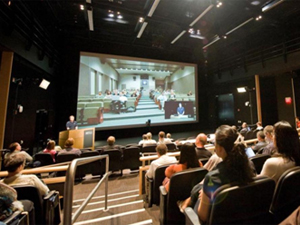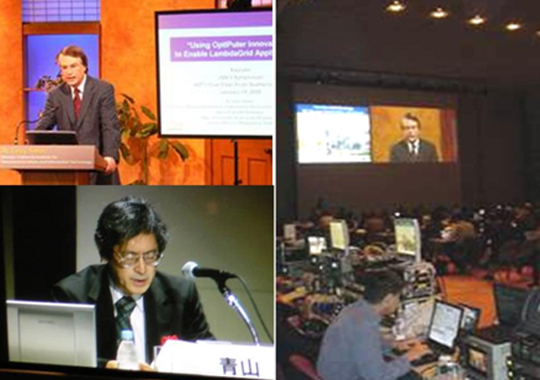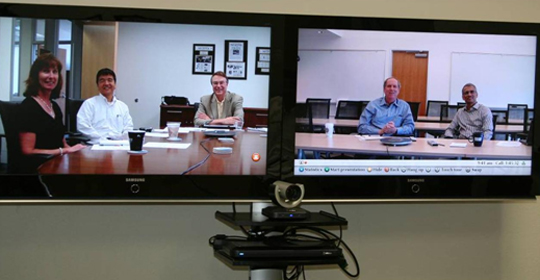Mixed Virtual/Physical Collaboration Spaces at Calit2: Collapsing the 'Flat' World to a Single Point
By Tiffany Fox, (858) 246-0353, tfox@ucsd.edu
San Diego, Calif., May 19, 2010 — When air travel ground to an ashen halt in Europe following Iceland's recent volcanic eruption, The New York Times reported that the videoconferencing industry — which makes it possible to communicate with counterparts thousands of miles away while sticking close to home – saw a significant spike in sales. But long before the ash cloud hampered travel, UC San Diego researchers in the California Institute for Telecommunications and Information Technology (Calit2) were using and developing cutting-edge systems to push videoconferencing into the next generation of so-called mixed virtual/physical technologies.
|
Living and working in the growing overlap of physical and virtual spaces has been a theme at Calit2 since the institute’s inception 10 years ago. Today, Calit2 has become one of the world's most advanced testbeds for virtual/physical collaboration spaces. These spaces make it possible for people to interact in real time with large data sets and wireless devices on local, regional, national and global scales, thereby increasing productivity and collaboration and reducing the collective carbon footprint.
"The last two decades of widely available shared Internet and the Web have made the world 'flat,' a level playing field," explains Calit2 Director and Internet pioneer Larry Smarr, referring to author Thomas L. Friedman's seminal work, "The Word is Flat: A Brief History of the Twenty-First Century." "But today's technological innovations – dedicated fiber paths, streaming HDTV and digital cinema, large display systems, and massive computing and storage – will in the coming decade reduce the world to a ‘single point,’ where data-intensive collaborations can occur in the same virtual place at the same time."
Calit2's most recent foray into mixed virtual/physical spaces involved equipping the auditoriums in its UC San Diego and UC Irvine buildings with high definition (HD) video capture and streaming equipment. The result: both divisions can participate face-to-face – on the big screens – in quarterly all-hands meetings without requiring researchers or staff to commute between the campuses. Remote collaboration between Calit2’s two auditoriums now takes place over a dedicated optical network using commercial LifeSize compressed HD video streams. To improve the flexibility of interactions between the auditoriums during joint meetings, Calit2 equipped the spaces with remote-controlled HD cameras and enhanced the lighting in the rooms. The institute is also installing 12-channel Meyer surround sound in the UCSD facility.
|
“The addition of the new equipment in our auditorium has aided our efforts to instill a true ‘two-campus, one-institute’ mindset at Calit2,” said GP Li, director of the institute’s UC Irvine division. “The two high-definition cameras and state-of-the-art streaming capabilities really added to the feeling of interactivity at our last all-hands meeting; it felt like the audiences in both auditoriums were sitting next to each other and we were all talking together. It’s like the difference between watching a football game on TV and being there in person.”
Calit2 was engaged in experiments with mixed virtual/physical collaboration spaces before the Calit2 buildings were completed. In January 2005, Director Smarr was invited to address the Japanese JGNII Symposiumin Kyoto, Japan. He accepted with the proviso that he give the lecture remotely using uncompressed video at 1500 Megabits per second. At that time, Smarr’s only option was to fly to Seattle and use the University of Washington’s ResearchChannel studios and their iHDTV uncompressed HDTV system. As Smarr recalls, Professor Aoyama, a Japanese pioneer in high resolution video over optical networks, exclaimed after the talk that, "I can see every hair on your head!"
|
By September 2005, as the Calit2 building at UCSD was becoming ready for occupancy, the San Diego division hosted a major international conference, iGrid 2005. During the opening session, Calit2 demonstrated the most advanced trans-Pacific experiment in high-resolution videoconferencing ever conducted. Streaming the live output of an Olympus digital cinema camera (4xHD) from Tokyo to the Calit2 auditorium and into the first Sony digital cinema projector in the U.S. allowed UCSD Chancellor Marye Anne Fox in San Diego and Keio University President Yuichiro Anzai to converse in real time during iGrid’s opening session. President Yuichiro Anzai, flanked by Japanese digital cinema pioneers in Tokyo, appeared in photo-realistic, digital-cinema quality video on the large Stewart 20x30 foot screen at Calit2.
The streaming was made possible by Calit2’s collaboration with NTT’s Network Innovation Laboratory, whose JPEG2000 encoder/decoders allowed the ultra-resolution video stream to be sent over a dedicated 1 Gigabit per second (Gbps) optical fiber network. The return stream to Japan was a more conventional commercial high-definition video stream. Establishing a 1 Gbps dedicated optical network in 2005 was not a small feat. The endeavor required a team of people working on the project exclusively for several weeks, as well as dedicated GLIF (Global Lambda Integrated Facility) trans-oceanic bandwidth.
Driven by the National Science Foundation-funded OptIPuter project, Calit2, the Electronic Visualization Laboratory at the University of Illinois at Chicago and their collaborators built out a national and international 10 Gbps dedicated optical fiber collaboration system (running over the National LambdaRail and GLIF). Tiled LCD display walls with PC clusters, termed “OptIPortals,” were developed to serve as scalable “termination devices” for the 10 Gbps “data fire hoses.” These OptIPortals are widely being deployed since they are constructed out of commodity components and all the software and instructions are freely available from the Calit2-led OptIPuter wiki. OptIPortals have now been constructed at 50-100 locations around the world.
No country has made a bigger commitment to deploying OptIPortals than Australia. In January 2008, the University of Melbourne – with Calit2’s Larry Smarr in virtual attendance – unveiled its 96-million-pixel OptIPortal visualization wall (known unofficially as the ‘OzIPortal’) constructed from twenty-four 30-inch LCD screens. Using Qvidium technology for light compression, the Calit2 auditorium was linked up with the U Melbourne OziPortal room at 140 Mbps. Ten months later, Monash University unveiled its 40-million-pixel wall that it uses to support researchers in its e-Research Centre. Most of Australia’s other major universities are following suit, linking together via AARNet as part of that country’s new strategy to deploy advanced bandwidth and cyberinfrastructure to ensure that Australian researchers will be able to collaborate fully with their counterparts around the world.
Calit2’s largest OptIPortal visualization system – the 287-million-pixel Highly Interactive Parallelized Display Space (HIPerSpace) – is frequently used for remote data-intensive collaboration, either directly on the wall, or via a standalone LifeSize system next to the wall.
|
This has made it possible for Calit2 director Smarr and HIPerSpace developers Falko Kuester (Calit2 Professor for Visualization and Virtual Reality) and Calit2 Project Scientist Kai-Uwe Doerr to work closely with the NASA Lunar Science Institute (LSI) at NASA Ames in northern California. The latest configuration allows the Calit2 team and their collaborators at NASA to manipulate high-resolution images on the HIPerSpace wall, while a Calit2 AESOP tiled wall (with only 7mm ‘glass to glass’ borders between the LCDs) supports the HD video at life size. The illusion is that the Calit2 lab and the NASA LSI lab have been joined together into one room with participants on both sides being the same size. This “sewing together” of the rooms is a major step beyond “sitting across the table talking to each other” that conventional videoconferencing enables.
“Mixed virtual/physical collaboration spaces leapfrog today's notion of telepresence, which is largely concerned with multi-site videoconferencing paired with laptop material that participants may share,” Kuester remarked. “For high-impact science and engineering collaboratories, it has to be possible to collaborate face-to-face on large-scale date collections that are represented in a format and at a level of resolution suitable for analysis.
Kuester added that these challenges are being tackled by Calit2's OptIPresence Tele-Immersion Testbed, which leverages HIPerSpace and its CGLX middleware as the baseline.
|
In addition to these “bleeding edge” mixed virtual/physical space experiments, Calit2 has made video collaboration routine by using commercial videoconferencing technologies developed by industry leaders such as Cisco Systems and LifeSize. Calit2's headquarters in Atkinson Hall is currently home to no fewer than nine LifeSize-equipped videoconferencing rooms and one Cisco CTS1000 telepresence room (the latter designed to specifications right down to the wall color and furniture selection). There are two LifeSize units at UCI and a telepresence room is being completed. A typical day will see multiple video conferences taking place as a normal part of Calit2 research projects.
|
"The Calit2 goal of building mixed virtual/physical spaces is to try to mimic the feeling of people meeting in the s ame space," says Calit2’s Media Technology Resources Manager, Hector Bracho. "Research shows that psychologically you're more engaged if you're in the same room while collaborating. That's why most of our technologies use a fixed camera that always presents the same view – it gives the viewer the feeling of looking through a window into the other room."
Reducing the collective carbon footprint is another advantage of working in virtual/physical spaces, at Calit2 and elsewhere. According to the Cisco TelePresence Calculator, a company with up to 1,500 employees and 5-10 global collaborators would avoid contributing more than 46,000 metric tons of carbon to the environment every five years by using its technology for four hours per day, at a cost savings of $16 million on travel.
Among the commodity products within its virtual/physical arsenal, Calit2 has opted to rely primarily on LifeSize and its standards-based H.323 approach to videoconferencing, which does not require the use of dedicated bandwidth and makes it possible to connect to most other users regardless of the H.323 system they use (by Polycom, Sony and other manufacturers). Such systems typically use about 2 Mbps bandwidth, which is almost 1,000 times less than the aforementioned uncompressed HD experiments.
|
Mixed virtual/physical systems are also narrowing the distance between Calit2 researchers and students abroad. The UCSD-based Pacific Rim Experiences for Undergraduates (PRIME) program sends students on summer research internships in Asia, and Australia's Monash University has launched a similar program to send its students to UC San Diego. Weekly conferences allow students in Melbourne to listen to lectures by Calit2 cyberinfrastructure experts while watching HD audio and video transmissions using the Qvidium technology.
Qvidium establishes a ‘point-to-point’ connection between two sites directly, providing more control of the end-to-end signal and latency. With its 140 Mbps bandwidth requirement, Qvidium permits streams with latencies of barely one-quarter of a second (250 milliseconds). That is a shorter delay than experienced by users of the highly compressed and widely used Skype – a ‘hosted’ service, requiring users to connect to Skype’s servers to communicate with each other, like IM or a telephone bridging service.
|
Calit2 uses Skype quite widely. "We often use Skype as a troubleshooting back-channel when we're experiencing difficulty with the higher-end technologies," notes Bracho. Director Smarr’s office lives the virtual/physical dream by using Skype to connect his assistant Kristen Johnson, who now lives in Menlo Park in northern California, to his other assistant Amy Bennion, who works in the UCSD Calit2 building. “Kristen and I work and talk with each other all day in essentially the same way we did when she was sitting in the desk next to mine,” says Bennion.
“The next step,” according to Calit2 Director of Visualization Tom DeFanti, “is to take telepresence into 3D, combining 3D stereo graphics and video, and surround sound that indicate and specify direction." The Calit2 NexCAVE, made from 3D consumer HDTVs, can be used as an immersive virtual reality 3D “telephone booth” so that virtual-reality users can benefit from telepresence as well.
"The NexCAVE is scalable from a few HDTV panels to a near-total surround environment," DeFanti continued. "As autostereo (3D without special glasses) becomes perfected, 3D telepresence will become more natural and ubiquitous – a focus of the Calit2 team with its REVE display research with the King Abdullah University of Science and Technology (KAUST) in Saudi Arabia, where Calit2 helped construct one of the most advanced set of visualization facilities in the world."
|
Calit2 Director Smarr said he expects mixed virtual/physical collaborations to become even more widespread as the demand for clean, green collaboration in tensifies.
”I believe that as the full impact of the climate changes which to result from continuing to dump greenhouse gas into the Earth’s atmosphere is realized, much greater use will be made of these mixed virtual/physical systems to avoid unnecessarily transporting our bodies.
"In the meantime," he continued, "these systems which Calit2 is prototyping allow investigators around the world to work together on a daily or weekly basis with the enormous scientific data sets that are becoming routine, greatly increasing research productivity.”
Media Contacts
Tiffany Fox, (858) 246-0353, tfox@ucsd.edu
Related Links
Electronic Visualization Laboratory
Center for Research in Computing and the Arts










